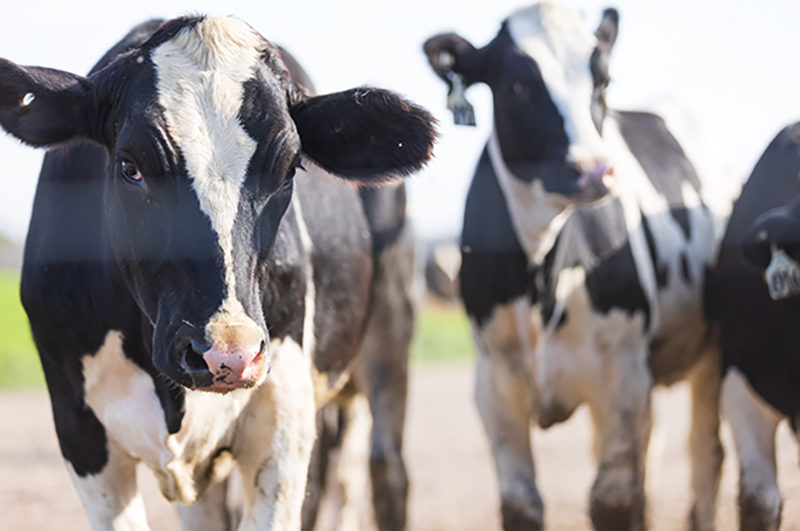There is a widespread misconception that dairies must wait to see financial returns from genomic testing — that cash-strapped dairies can’t justify the investment for potential long-term gains. A close look at the numbers produced from a carefully considered genomic testing plan tells a different story — one of increased efficiency and more immediate returns. But how?
1. Right-size heifer inventory
Using a genomic test that includes adult cow and calf wellness traits to predict risks for common and costly diseases, you can generate more immediate information to identify which heifers are genetically more likely to survive, thrive and advance to their production prime in your herd. At an average raising cost of $2,200 1,2,3 per calf, just think of what you could save by identifying heifers most susceptible to mastitis, metritis, milk fever (for Jerseys), respiratory disease and scours at a young age?
This potential savings could help cover genomic testing costs and focus your heifer-raising investments on heifers that can help you grow your bottom line.
Many dairies don’t understand just how much excess they have. I worked with a herd that had 40% too many calves. It was eye-opening for this operation to pencil out raising costs for all of those heifers, especially not knowing if they’d all make successful replacements. To right-size their inventory, we used information generated from genomic testing to identify and remove the bottom 20% of heifers. This freed up heifer-raising costs. The dairy applied these costs-savings to support genomic testing expenses. Could you confidently manage heifer inventory without genomic testing information?
2. Apply more strategic breeding strategies
The other part of helping to free up cash flow for genomic testing is coming up with breeding strategies with the goal of creating the most valuable calves. The most valuable calves in today’s market are beef cross calves. This is because beef cross calves are worth about $100 a head more than Holstein calves, on average.4 If I get herds using a lot of sexed semen and beef semen — and very little conventional semen — a lot of them can create up to 40% as beef-cross calves. The premium generated from these calves brings approximately $40 more in value per calf. This can cover costs for genomic testing and sexed semen.
How Much Cash Flow Can Genomic Testing Generate?
To give you an idea of potential cash flow opportunities, the models below demonstrate how a 300-cow herd could generate additional income, approximately $8,000, by applying genomic testing strategies that included breeding with sexed semen ($25/unit) and beef semen ($5/unit). To compare semen costs, I plugged in a “current” scenario using sexed semen on the top half of heifers (2x) and conventional semen to breed the rest. Using increased conception rates for heifers, I came in around $6,000 for “current” semen costs.
Option 1: Generating approximately $8,000 additional income:
Using the figure of beef calves being worth an extra $100 more each than purebred Holstein calves,4 this aggressive strategy could produce an additional income of $13,600, a net gain of over $8,000 for the dairy. This increase would not only pay for the sexed semen, but also cover the costs of genomic testing with some to spare (144 X $43 = $6,192).
The strategy: All sexed or all beef semen
- All heifers bred with sexed semen
- First-lactation cows: Top 65% on sexed semen (2x); all others are beef semen
- Second-lactation cows: Top 25% on sexed semen (2x); all others are beef semen
The results:
- 12 dairy heifers created a month
- Semen cost is $11,500 or an increase of $5,500 (compared with “current” scenario before strategy change)
- Beef calves: 136 per year
Option 2: Generating approximately $6,000 additional income:
This less aggressive approach uses more sexed semen, but not exclusively sexed and beef, for producers who perhaps don’t want to extend themselves to the degree of the first example. Nonetheless, this strategy would produce approximately $6,000 of additional income considering beef calves are each worth an extra $100 compared with purebred Holstein calves.4
The strategy: more sexed semen, but no exclusively sexed or beef semen
- All heifers bred with sexed semen (3x); followed by conventional semen
- First-lactation cows: Top 25% on sexed semen (2x); followed by conventional semen; next 35% on only conventional semen; bottom 40% on beef semen
- Second-lactation cows: Top 10% on sexed semen (1x); then conventional; next 30% on conventional semen; bottom 60% on beef semen
The results:
- 12 dairy heifers created a month
- Semen cost is about $4,000 more than “current” scenario before strategy change
- Beef calves: 103 per year
Source: Dave Erf, dairy technical services geneticist, Zoetis
Adjusting and Evaluating Genomic Testing Strategies
Right-sizing heifer inventories and applying different breeding strategies can be awkward. The biggest concern is that these strategies will lead to heifer shortages. It’s true that heifer inventory needs will decrease as we create heifers with the best genetics and cows tend to last longer.
Part of adjusting the strategy as the ideal makeup of the herd improves is resetting expectations to make sure you don’t have to sell older, more profitable cows. As herds make more and more heifers, turnover rates can creep up. It’s becoming more common to see herds with 45% turnover rates, well above the industry average of 35% to 36%.
At this point, management becomes about monitoring culling decisions. Make culling decisions that give profitable animals the opportunity to live out their profitable lives.
In addition to decreased heifer inventory needs, another change that can require adjustments is improved pregnancy rates. When pregnancy rates improve more calves are made. You may need to adjust the strategy to use more beef semen because heifers and cows are becoming pregnant quicker.
The only way to be aware of these adjustments is to consistently apply an informed genomic testing plan and evaluate the outcomes.
The Benefits of On-Farm Support
When choosing a genomic test and implementing the plan, it’s important to understand the level of service and support that comes with the test. Successfully interpreting genomic test results and applying the information requires support from real, live representatives to help conduct herd audits, establish plans, develop on-farm testing procedures, interpret the genomic information and evaluate testing strategies.
References
1. Overton M, Dhuyvetter KC. Economic considerations regarding the raising of dairy replacement heifers. In: Beede D, ed. Large Dairy Herd Management. 3rd ed. Champaign, IL: American Dairy Science Association, 2017;457-474.
2. Heinrichs J, Gabler M, Tozer P, Schriefer T. Heifer Economics. https://extension.psu.edu/heifer-economics. Opens in a new window. Updated Jan. 3, 2018. Accessed Feb. 25, 2019.
3. Tranel L. What’s It Cost to Raise Heifers? https://www.extension.iastate.edu/dairyteam/files/documents/whats_it_cost_to_raise_heifers_2019_0.pdf. Opens in a new window. Accessed Feb. 25, 2019.
4. Cattle and Calf Auction Report for Wednesday, March 13, 2019 USDA - Cornell Dept Anim Sci, NYS Dept Ag & Mkts, Albany, NY. https://cpb-us-e1.wpmucdn.com/blogs.cornell.edu/dist/3/3955/files/2019/03/CherryCr_3-13-19-1pauxo6.pdf. Opens in a new window. Accessed March 26, 2019.
All trademarks are property of Zoetis Services LLC or a related company or a licensor unless otherwise noted. CIDR is a registered trademark of InterAg.
©2023 Zoetis Services LLC. All rights reserved. CLR-00398R1
Written By: Dave Erf, Geneticist, U.S. Dairy Technical Services, Zoetis









